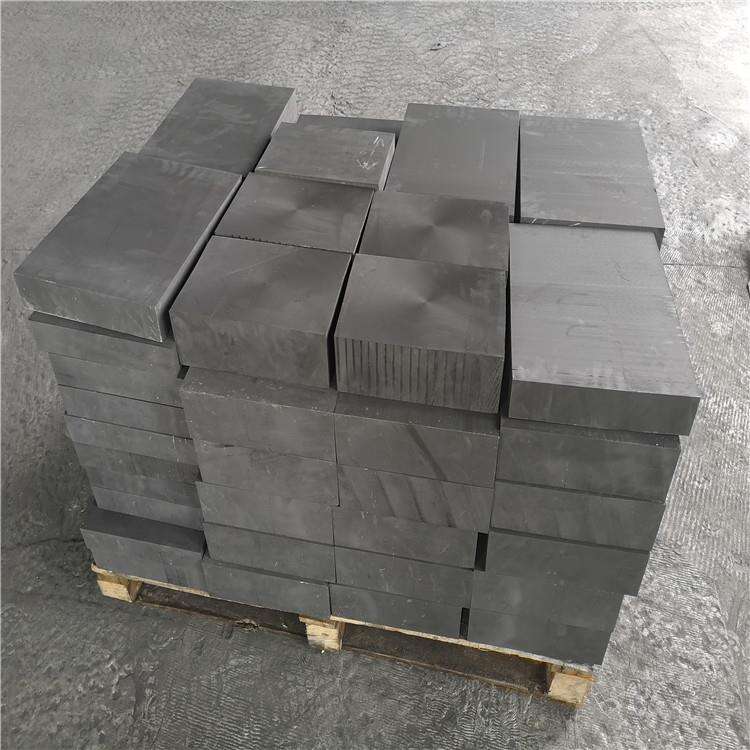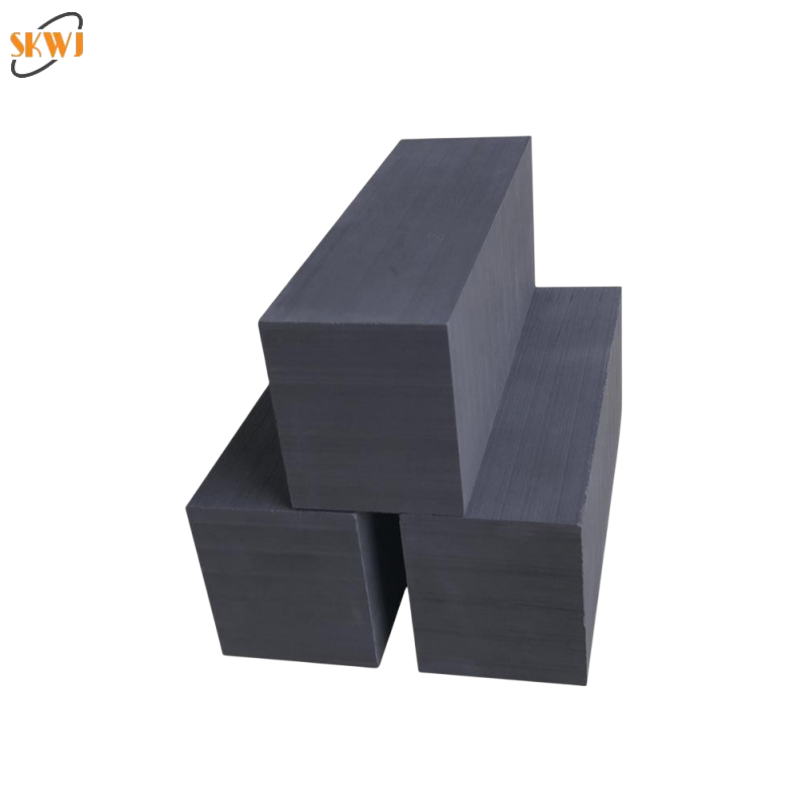Karbon Əsaslı Materialların İstilik Ötürmə Səmərəliliyinin Anlaşıılması
Yüksək temperatur və dəqiqlik tələb edən sənayelərdə istilik idarəetmə materiallarının seçilməsi operasiya səmərəliliyində mühüm rol oynayır. Qrafit bloklar , unikal quruluşu və fiziki xassələri ilə tanınan bu materiallar, müxtəlif tətbiq sahələrində istilik keçiriciliyi üçün ən effektiv materiallardan birinə çevrilib. Yüksək istilik keçiriciliyi, kimyəvi müqavimət və struktur sabitliyi ilə birləşərək, onları digər materialların parçalanacağı, oksidləşəcəyi və ya deformasiya olunacağı mühitlərdə üstünlük təşkil edən seçim edir. Bu məqalə qrafit blokların istilik keçiriciliyinə təsir edən amilləri araşdırır və sənayedəki əhəmiyyətini izah edir.
İstilikötürməyə Təsir Edən Quruluş və Fiziki Xassələr
Kristal Quruluşun İstilik Performansında Oynadığı Rol
Qrafit blokların yüksək istilik keçiriciliyi əsasən onların anizotrop kristal quruluşuna görədir. Qrafit, heksaqonal həll quruluşunda düzülən karbon atomlarının təbəqələrindən ibarətdir. Hər bir təbəqə daxilində karbon atomları sıx bağlanmışdır və bu da təbəqə boyunca istiliyin səmərəli keçidinə imkan verir. Bu müstəvidə olan rabitələr elektronların sürətli hərəkətinə yol açır ki, bu da qrafitin istiliyi effektiv şəkildə keçirməsinin əsasını təşkil edir. Bu təbəqələrin müstəvisində istilik keçiriciliyi onlara perpendikulyar istiqamətdən xeyli yüksəkdir, bu da qrafit blokları istiqamətləndirilmiş istilik axını tələb edən tətbiqlər üçün xüsusi olaraq uyğun edir. İstilik keçiriciliyi ümumiyyətlə bircins olan metalların əksinə, qrafitin istiqamətləndirilmiş istilik köçürülməsi mühəndis sistemlərində strategiyalı şəkildə istifadə edilə bilər.
Sıxlıq və təmizliyin istilik köçürülmə sürətinə təsiri
Qrafit blokların istilik keçiriciliyi həmçinin onların sıxlığı və təmizlik səviyyəsindən də asılıdır. Daha yüksək sıxlığa malik bloklar istilik müqavimətini azaldan sıx strukturu nəzərə alınmaqla daha yaxşı istilik keçiriciliyi təmin edir. Eyni şəkildə, kül, oksidlər və ya metallik daxili qarışıqlar fonon daşınma mexanizmlərini pozur və ümumi keçiriciliyi azaldır. Sənaye qrafit blokları tez-tez karbon təbəqələrinin hizalanmasını və sıxlığını optimallaşdırmağa kömək edən izostatik presləmə və ya ekstrüziya kimi proseslər vasitəsilə istehsal olunur. Bundan əlavə, adətən 99,9% -dən çox karbon tərkibinə malik olan yüksək təmizlikli qrafit istilik sabitliyini artırır və onu həssas və ya yüksək istilik tələb edən tətbiqlər üçün daha etibarlı edir.

Digər istilik keçiriciləri ilə müqayisəli analiz
Qrafit və Ənənəvi Metal Keçiricilər
İstilik keçiriciliyini qiymətləndirərkən qrafit blokları mis, alüminium və nömrəli polad kimi metal alternativlərlə müqayisə etmək təbii haldır. Məsələn, mis yaxşı istilik keçiriciliyi ilə məlumdur, adətən təxminən 400 Vt/m·K. Bununla belə, yüksək keyfiyyətli qrafit blokların istilik keçiriciliyi ətələrinə paralel olaraq 200 Vt/m·K-dan artıq ola bilər. Bu göstərici sənədlərdə daha aşağı görünə bilər, lakin qrafit bir neçə aydın üstünlüklər təqdim edir. O, ekstremal temperaturlarda daha yaxşı işləyir, inert və ya reduksiya edən mühitlərdə oksidləşməyə davam gətirir və metalların əksinə ərimir. Əlavə olaraq, qrafit bloklar mürəkkəb soyutma sistemləri və ya qoruyucu örtüklər tələb etmədən sabit keçiricilik saxlayır və çox isti mühitlərdə daha az təmir tələb edən həll yolu təqdim edir.
Keramika əsaslı materiallara nisbətən üstünlüklər
Bəzi tətbiqlərdə keramiklər istilik müqaviməti və elektrik izolyasiyası üçün nəzərdən keçirilir. Bununla belə, onların qəbrit təbiəti və aşağı istilik keçiriciliyi – tez-tez 30 Vt/m·K-dan aşağı – dinamik və ya yüksək istilik axını olan mühitlərdə istifadələrini məhdudlaşdırır. Qrafit bloklar keramiklərdən istilik keçiriciliyi baxımından üstünlük təşkil edir və həmçinin daha yaxşı emal olunma qabiliyyəti və təsadüfi yüklərə qarşı müqavimət göstərir. Onları struktur bütövlüyünü itirmədən asanlıqla formalaşdırmaq və dəyişdirmək olar ki, bu da çoxsaylı keramik materiallar üçün əsas məhdudiyyətdir. Bu, qrafiti istilik keçiriciliyinin mexaniki davamlılıqla tarazlaşdırılması lazım olan sistemlərdə praktiki və uyğunlaşan həll halına gətirir.
Yüksək istilik keçiriciliyi tələb edən sənaye tətbiqləri
Istilik mübadiləsi aparatlarında və yüksək temperaturlu sobalarda istifadə
Qrafit bloklar istilik mübadilə cihazlarının hazırlanmasında və konstruksiyasında, xüsusilə korroziyaedici və ya yüksək temperaturlu mühitlərdə geniş istifadə olunur. İstiliyi səmərəli şəkildə ötürmə qabiliyyəti kimyəvi parçalanmaya qarşı müqavimət göstərməsi onları kimyəvi emal və energetika sektorlarında qiymətli edir. Yüksək temperaturlu sobalarda qrafit bloklar izolyasiya materialları, dəstək konstruksiyaları və istilik yayıcılar kimi xidmət edir. Onların istilik keçiriciliyi sinterləmə, metal təməl alma və yarımkeçirici istehsalı kimi proseslərin keyfiyyətini və səmərəliliyini artırmaq üçün bərabər temperatur paylanması təmin edir. Qrafitin möhkəmliyi və termiki sabitliyi də eyni zamanda təmir işlərinin tezliyini azaldır və avadanlıqların iş vaxtını artırır.
Elektronika və batareya istehsalında tətbiqi
Müasir elektronika və enerji saxlama sistemləri, çoxlu çəki əlavə etmədən və ya sıradan çıxma riski olmadan istiliyi səmərəli şəkildə udmağa qadir olan materiallara tələb yaradır. Qrafit bloklar artıq istilik yayıcılar, termal interfeys materialları və batareyanın qabları kimi istifadə olunur. Elektrik keçiriciliyi xüsusi tətbiq sahələrində, məsələn, lityum-ion batareyaların istehsalında, həm elektrik, həm də termal performans kritik əhəmiyyət kəsb etdiyində üstünlük təşkil edir. Metal əsaslı həllərlə müqayisədə qrafit daha yüngül, korroziyaya davamlı alternativ təqdim edir və müxtəlif temperatur və nəmlik səviyyələrində öz xassələrini saxlayır. Bu cəhətdən qrafit bloklar daha təhlükəsiz və səmərəli elektron sistemlərin inkişafında strateji material kimi tanınır.
Dinamik Mühitdə İcra Faktorları
Termal Dövrlər Şəraitində Davranış
Termal dövretmə, materialın dəfələrlə qızdırılması və soyutulmasını, nəticədə isə yorulma, çatlamalar və nəhayət dağlanmaya səbəb olur. Qrafit bloklar termal dövretməyə müstəsna müqavimət göstərir, əsasən termal genişlənmə əmsalının aşağı olması ilə bağlıdır. Bu onların temperatur dalğalanmalarına məruz qalma zamanı belə minimal ölçülərinin dəyişməsinə səbəb olur. Metal sistemlərdə termal dövretmə, istismar, oksidləşmə və performansın zamanla pisləşməsinə səbəb olan material gərginliyinə səbəb ola bilər. Termal yüklər altında qrafitin möhkəmliyi onu şüşə istehsalı və günəş paneli istehsalı kimi proseslər üçün ideal edir, burada proses sabitliyi üçün termal xassələrin sabitliyi çox vacibdir.
İstismar atmosferinin keçiriciliyə təsiri
Qrafit blokların performansı ətraf mühitin təsirindən asılı olaraq dəyişə bilər. Oksidləşdirici mühitdə qrafit 500°C-dən yuxarı temperaturlarda parçalanmaya meyillidir, əgər onlar örtüklər və ya inert qazlarla qorunmur. Əksinə, vakuum və ya inert qaz mühitində (məsələn, azot və ya arqon kimi) qrafit bloklar keçiriciliyin əhəmiyyətli dərəcədə itirilmədən 3000°C-ə qədər temperatur dözümlülüyünə malikdir. Qrafit materiallarının ömrünü və performansını optimallaşdırmaq üçün əlverişli şəraitin seçilməsi vacibdir. Səth müalicəsi və konstruksiya dəyişiklikləri kimi qoruyucu tədbirlər qrafitin çətin şəraitdə termal dözümlülüyünü daha da artırmağa kömək edə bilər.
İqtisadi və Ətraf Mühit Faydaları
Aşağı Enerji Sərfiyyatı və Sistem Səmərəliliyi
Termal idarəetmə sistemlərində qrafit blokların istifadəsi enerjinin əhəmiyyətli qədər qənaətinə səbəb ola bilər. Effektiv istilik keçiriciliyi sayəsində daha sürətli qızdırma dövrləri və daha bərabər temperatur nəzarəti təmin edilir, bu da enerji itkisinin və proses dəyişkənliyinin azalmasına kömək edir. Metallurgiya və yarımkeçirici istehsalı kimi sahələrdə, burada termal sabitlik əsas amildir, bu, daha yüksək çıxım nisbətləri və aşağı operation xərcləri ilə nəticələnir. Bundan əlavə, qrafitin istifadəsi tez-tez əlavə termal idarəetmə komponentlərinin ehtiyacını aradan qaldırır, sistem dizaynını sadələşdirir və ümumi elektrik istehlakını azaldır.
Qrafit blokların davamlılığı və təkrar emalı
Yüksək performansın kənarında, qrafit bloklar əhəmiyyətli ekoloji üstünlüklər təklif edir. Onlar həm təbii qrafitdən, həm də sintetik proseslərdən istifadə edilərək əldə edilə bilər və bir çox istehsalçılar təbii qrafitin davamlı hasil edilməsi və emissiya səviyyəsi aşağı olan istehsal üsullarına diqqət yetirirlər. Qələvi metalların istehsalı üçün ənənəvi olaraq tələb olunan intensiv qazıntı və ərimə proseslərindən fərqli olaraq, qrafit materiallarının karbon izi daha azdır. Bundan əlavə, istifadə edilmiş qrafit blokları təkrar emal edilə, yenidən işlənilə və ya başqa məqsədlər üçün istifadə edilə bilər ki, bu da materialların təkrar emalına əsaslanan iqtisadiyyata töhfə verir. Uzun ömrü və minimal təmir tələbləri ilə tullantıların azalmasına da kömək edirlər və bu da sənayenin daha ekoloji təmiz və davamlı istehsal üsullarına keçidinə uyğundur.
Gələcək İmtahanlar və Yeni Texnologiyalar
Növbəti Nəsil İstilik Sistemlərində Qrafit
Sənayenin daha sürətli, yüngül və səmərəli sistemlərə olan tələbi artırcaqca, qrafit blokların rolu genişlənməlidir. Yüksək təmizlikli sintetik qrafit və kompozit materiallarda innovasiyalar qrafitin əldə edə biləcəyi nəticələrin həddini artırır. Bu inkişaflar, həm istilik performansını, həm də mexaniki möhkəmliyi eyni anda artırmaq üçün qrafiti polimerlərlə və ya keramiklərlə birləşdirən hibrid materialları əhatə edir. Qrafit bloklar həmçinin, çəki-istilik nisbəti və termal etibarlılığın kritik amillər olduğu kosmik sənaye, nüvə enerjisi və bərpa olunan texnologiyalarda yeni tətbiq sahələri tapır.
İstifadə Tendensiyaları və Material İnkişafı
Bazar məlumatları qrafit əsaslı materialların inkişafına xüsusilə enerji və elektronika tətbiqlərinə yönəlmiş investisiyaların artıqda olduğunu göstərir. Qlobal səviyyədə karbondan çıxmaq və təmiz enerjiyə keçid təbliğ edildiyinə görə, elektrik və istilik keçiriciliyi kimi ikiqat xassələri ilə qrafit yeni texnologiyaların inkişafında mühüm rol oynayır. Qrafen və digər karbon allotroplarının öyrənilməsi də ultraeffektiv istilik idarəetmə həllərinin yaradılmasına imkan verir. Hal-hazırda qrafit bloklar yoxlanılmış və etibarlı material kimi mövcuddur, lakin onların təkamülü yeni başlamışdır və gələcək mühəndislikdə təsiri əhəmiyyətli olacaqdır.
SSS
Niyə qrafit bir istiqamətdə digərindən daha çox istilik keçiricidir?
Qrafitin kristal quruluşunda hər bir təbəqənin müstəvisində güclü karbon-karbon rabitələri və təbəqələr arasında zəif Van-der-Vaals qüvvələri mövcuddur. Bu, istiliyin keçiriciliyinin müstəvi boyunca perpendikulyar istiqamətdən daha yüksək olmasına səbəb olur və istilik köçürməsi üçün istiqamətlənmiş effektivlik yaradır.
Qrafit bloklar oksidləşdirici mühitdə necə davranır?
Oksidləşdirici mühitdə qrafit təxminən 500°C-də parçalanmağa başlayır. Bununla belə, qoruyucu örtüklər və ya inert qaz mühitinin istifadəsi qrafitin istifadə oluna bilən temperatur diapazonunu əhəmiyyətli dərəcədə artırır, onun yüksək temperaturlarda belə yüksək keçiriciliyini saxlamasına imkan verir.
Qrafit bloklar misdən istilik keçirmə baxımından daha yaxşıdır?
Ümumiyyətlə mis daha yüksək istilik keçiriciliyinə malikdirsə də, qrafit bloklar yüksək temperaturlarda daha yaxşı performans, daha yaxşı kimyəvi müqavimət və daha aşağı çəki təmin edir. Ətraf mühitin sabitliyi və xidmət müddəti mütləq keçiriciliyə nisbətən daha vacib olduğu tətbiqlərdə tez-tez daha sərfəli variant hesab olunur.
Qrafit bloklar elektronika soyutma sistemlərində istifadə oluna bilərmi?
Bəli, qrafit bloklar yüksək istilik keçiriciliyinə, yüngül konstruksiyasına və korroziya və ya yorulmadan müxtəlif temperatur diapazonunda işləmə qabiliyyətinə malik olduqları üçün elektronika və batareyalar üçün soyutma sistemlərində geniş istifadə olunur.
Mündəricat
- Karbon Əsaslı Materialların İstilik Ötürmə Səmərəliliyinin Anlaşıılması
- İstilikötürməyə Təsir Edən Quruluş və Fiziki Xassələr
- Digər istilik keçiriciləri ilə müqayisəli analiz
- Yüksək istilik keçiriciliyi tələb edən sənaye tətbiqləri
- Dinamik Mühitdə İcra Faktorları
- İqtisadi və Ətraf Mühit Faydaları
- Gələcək İmtahanlar və Yeni Texnologiyalar
- SSS






